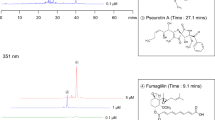Abstract
The antifungal protein (AFP) secreted by the mould Aspergillus giganteus is a small, highly basic polypeptide with antifungal activity. Previous work has shown that transcription of the corresponding afp gene is regulated by ambient pH, being suppressed under acidic and strongly induced under alkaline conditions. This observation suggested that the afp gene is regulated by the wide-domain transcriptional factor PacC. Here, we show that two putative PacC binding sites within the afp promoter, denoted afpP1 and afpP2, are efficiently recognised in vitro by a PacC fusion protein of A. nidulans. In addition, we found that phosphate, which was used as a buffering agent during cultivation, plays an important role in regulating afp expression. AFP production was nearly completely inhibited in the presence of external phosphate. The results of Northern analysis indicate that the inhibitory effect of phosphate is mediated at the transcriptional level.
Similar content being viewed by others
References
Denison SH (2000) pH regulation of gene expression in fungi. Fungal Genet Biol 29:61–71
Espeso AE, Peñalva MA (1996) Three binding sites for the Aspergillus nidulans PacC zinc-finger transcription factor are necessary and sufficient for regulation by ambient pH of the isopenicillin N synthase gene promoter. J Biol Chem 271:28825–28830
Espeso EA, Tilburn J, Arst HN Jr, Peñalva MA (1993) pH regulation is a major determinant in expression of a fungal penicillin biosynthetic gene. EMBO J 12:3947–3956
Espeso EA, Tilburn J, Sanchez-Pulido L, Brown CV, Valencia A, Arst HN Jr, Peñalva MA (1997) Specific DNA recognition by the Aspergillus nidulans three zinc finger transcription factor PacC. J Mol Biol 274:466–480
Espeso EA, Roncal T, Diez E, Rainbow L, Bignell E, Álvaro J, Suârez T, Denison SH, Tilburn J, Arst HN Jr, Peñalva MA (2000) On how a transcription factor can avoid its proteolytic activation in the absence of signal transduction. EMBO J 19:719–728
Hanel F, Grafe U, Roth M, Bormann EJ, Krebs D (1985) Influence of inorganic phosphate on the lipid synthesis of a phosphate-deregulated mutant of Streptomyces noursei. J Basic Microbiol 25:323–325
Kronstad J, De Maria A, Funnell D, Laidlaw RD, Lee N, De Sa MM, Ramesh M (1998) Signalling via cAMP in fungi: interconnections with mitogen-activated protein kinase pathways. Arch Microbiol 170:395–404
Lacadena J, Martinez del Pozo A, Gasset M, Patino B, Campos-Olivas R, Vazquez C, Martinez-Ruiz A, Mancheno JM, Onaderra M, Gavilanes JG (1995) Characterization of the antifungal protein secreted by the mould Aspergillus giganteus. Arch Biochem Biophys 324:273–281
Lengeler KB, Davidson RC, D’Souza C, Harashima T, Shen WC, Wang P, Pan X, Waugh M, Heitman J (2000) Signal transduction cascades regulating fungal development and virulence. Microbiol Mol Biol Rev 64:746–785
Meyer V, Wedde M, Stahl U (2002) Transcriptional regulation of the Antifungal Protein in Aspergillus giganteus. Mol Genet Genomics 266:747–757
Miller H (1987) Practical aspects of preparing phage and plasmid DNA: Growth, maintenance and storage of bacteria and bacteriophage. Methods Enzymol 152:145–170
Mingot JM, Tilburn J, Diez E, Bignell E, Orejas M, Widdick DA, Sarkar S, Brown CV, Caddick MX, Espeso EA, Arst HN Jr, Peñalva MA (1999) Specificity determinants of proteolytic processing of Aspergillus PacC transcription factor are remote from the processing site, and processing occurs in yeast if pH signalling is bypassed. Mol Cell Biol 19:1390–1400
Olson BH, Goerner GL (1965) Alpha Sarcin, a new antitumor agent. Isolation, purification, chemical composition and the identity of a new amino acid. Appl Microbiol 13:314–321
Orejas M, Espeso EA, Tilburn J, Sarkar S, Arst HN Jr, Peñalva MA (1995) Activation of the Aspergillus PacC transcription factor in response to alkaline ambient pH requires proteolysis of the carboxy-terminal moiety. Genes Dev 9:1622–1632
Sambrook J, Fritsch EF, Maniatis T (1989) Molecular cloning: a laboratory manual, 2nd edn. Cold Spring Harbor Laboratory Press, Cold Spring Harbor, N.Y.
Schmitt E, Kempken R, Kück U (2001) Functional analysis of promoter sequences of cephalosporin biosynthesis from Acremonium chrysogenum: specific DNA-protein interactions and characterization of the transcription factor PACC. Mol Genet Genomics 265:508–518
Suárez T, Peñalva MA (1996) Characterization of a Penicillium chrysogenum gene encoding a PacC transcription factor and its binding sites in the divergent pcbAB-pcbC promoter of the penicillin biosynthetic cluster. Mol Microbiol 20:529–540
Tilburn J, Sarkar S, Widdick DA, Espeso EA, Orejas M, Mungroo J, Peñalva MA, Arst HN Jr (1995) The Aspergillus PacC zinc finger transcription factor mediates regulation of both acid- and alkaline-expressed genes by ambient pH. EMBO J 14:779–790
Weinberg D (1978) Secondary metabolism: regulation by phosphate and trace elements. Folia Microbiol (Prague) 23:496–504
Wenz P, Schwank S, Hoja U, Schüller HJ (2001) A downstream regulatory element located within the coding sequence mediates autoregulated expression of the yeast fatty acid synthase gene FAS2 by the FAS1 gene product. Nucleic Acids Res 29:4625–4632
Wnendt S, Ulbrich N, Stahl U (1994) Molecular cloning, sequence analysis and expression of the gene encoding an antifungal protein from Aspergillus giganteus. Curr Genet 25:519–523
Yelton MM, Hamer JE, Timberlake WE (1984) Transformation of Aspergillus nidulans by using a trpC plasmid. Proc Natl Acad Sci USA 81:1470–1474
Zhang J, Wolfe S, Demain AL (1988) Phosphate repressible and inhibitable β-lactam synthetases in Cephalosporium acremonium strain C-10. Appl Microbiol Biotechnol 29:242–247
Author information
Authors and Affiliations
Corresponding author
Additional information
Communicated by U. Kück
Published online: 18 September 2002
An erratum to this article is available at http://dx.doi.org/10.1007/s00294-005-0567-3.
Rights and permissions
About this article
Cite this article
Meyer, V., Stahl, U. New insights in the regulation of the afp gene encoding the antifungal protein of Aspergillus giganteus . Curr Genet 42, 36–42 (2002). https://doi.org/10.1007/s00294-002-0324-9
Received:
Revised:
Accepted:
Issue Date:
DOI: https://doi.org/10.1007/s00294-002-0324-9




